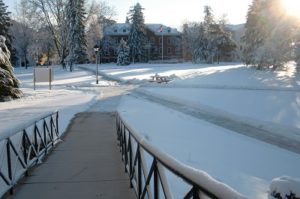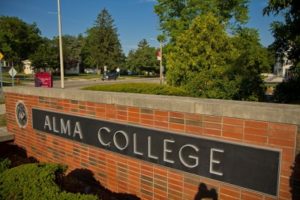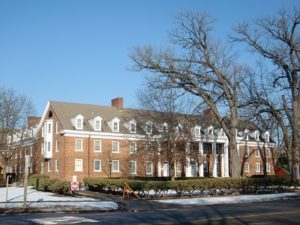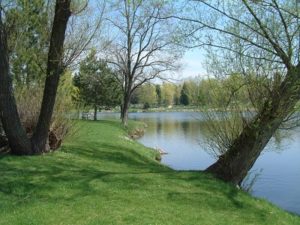Albion College is situated in Albion, Michigan and about 90 miles west of Detroit, but the lifestyle there is a million miles away from the very urban “Motorcity.” The town of Albion has a population of only nine thousand full time residents, and the school itself is home to nearly 1,400 students, making it one of the most important features of the town. “The Britons” enjoy a student to faculty ratio of only 11 to 1 and the “Albion Advantage” includes a 340 acre equestrian center. Affiliated with the United Methodist church, Albion continues a liberal arts tradition dating back to 1835.

Albion College
Situated 50 miles north of the state capital is Alma College in Alma, Michigan. Like Albion, Alma College is also in a very small town, also affiliated with a church, also having a similar student population, and also having a similar student to faculty ratio. Alma has an acceptance rate of just over 70%, only higher than Albion’s by a couple percentage points.
It becomes very clear, very quickly, when comparing these two schools, that they are strikingly similar in terms of vital statistics. It was the aim of our survey to find out the important differences between the two colleges for prospective students, so we asked some from each school questions ranging from academic aspects, to campus life issues. Here is what we found.
Academics
In terms of workload, 30 percent of students at both schools described the work as “difficult,” saying “it consumes most of my time.” The difference, here, was at the other end of the spectrum where 15 percent of Albion students described the difficulty of workload to be “very manageable” to “occasionally difficult;” no Alma students felt this way. 65 percent, a strikingly large number of Alma students, described the work as “manageable” with a “reasonable amount of work.”
In line with this finding is the actual number of hours students at both schools spent studying. Again, a very large percentage of Alma students, 65 percent, studied 3 to 4 hours a day; 18 percent said they studied 1 to 2 hours a day. At Albion College, a larger, 32 percent of students, would only be found in the books for 1 to 2 hours a day. Those studying 3 to 4 hours a day amounted to 45 percent.
None of the students, at either college, found the academic environment to be “highly competitive.” On the contrary, 55 percent of Albion students and 65 percent of Alma students responded that the Academic environment was “collaborative.” Further, 25 percent of Alma students described the environment as “Highly collaborative;” fewer Albion students, 10 percent, would go so far.

Alma College
One Alma sophomore said, “I like everything about Alma, you get one of the best educations out there, and you get a lot of one on one time with professors you can’t really get at a large university.”
This was echoed by an Albion senior: “Albion College is an awesome school. The professors and students are all great. Collaboration is everywhere, and both students and professors are highly involved with regards to every aspect of college activities and community relations.
Faculty
As is clear, the distinct advantage small schools have over larger ones is the relationship you are able to develop with professors, and 62 percent of Albion students conversed with professors about classroom topics outside of class “weekly.” The same was true for an amazing 72 percent of Alma students.
This carried over into the satisfaction students had with their advisors as well. An Alma junior said, “My advisor is great! She got to know the person that I am outside of the classroom to better help me academically.”
45 percent of students at both schools were “very satisfied” with the guidance they received from their advisors, and 50 percent were “satisfied.” Clearly, this speaks well of both schools and the liberal arts experience in general.
The words of an Albion senior exemplify what we mean: “I love the professors. There’s a real sense of community that’s created with them, by doing events together with undergraduates and undergraduate research. It is so easy to invite a professor to a fundraiser, and have he/she bring their entire family to help out.”

Albion College
Campus Life
We started this part of our survey with questions about housing. The similarities between the two schools were evident here as well, the difference being that students at Alma were more likely to be “very satisfied” with their housing situation. 31 percent of Alma students responded this way, and slightly less, 22 percent of Albion students, felt this strongly. An additional 31 percent of Alma students responded that they were “satisfied.”
Statistics do not tell all, however. Comments from Alma students tell a different story: “Many dorms and small housing units are very old and not well maintained,” and “…I don’t always love the community bathroom and laundry rooms because there’s a lot of things (i.e. pipes, or dry wall, or general repairs) that are going on.” This aspect, in addition to the food on campus, seemed to be sore spots among the Alma students.
Students at both schools, once again, however, were in agreement about a sense of community on campus, with the majority at both schools responding that there was a “strong sense of community on campus.” 35 percent of students at both colleges felt a “very strong” sense of community on campus.
“Alma College has created a culture of involvement, providing students with unique opportunities for research and service. Along the way bonds are formed with students and staff that carry on after college,” said an Alma sophomore.
Yet, there were differences in terms of interaction with the local community. An overwhelming majority, 65 percent of students at Albion, felt only “somewhat close,” and had only “occasional interaction” with the local community. 45 percent of students at Alma, on the other hand, felt “close” and had “frequent interaction” with the local community. Nearly 30 percent of Alma students felt “very close” ties to the community. This is a significant difference between two very similar schools, and one that prospective students would do well to take into consideration.
Social Scene
The observations concerning ties to the local community are reflected in the fact that the vast majority, greater than 80 percent of Albion students, said that the balance of social life was “mainly on-campus.” At Alma, only about half as many students felt this way, and an equal number felt that there was an “equal balance” between on and off campus social life. It follows, then, that campus activities are well attended at Albion. The majority of Alma students said that only “some people” attend the college-sponsored activities, where the majority of Albion students said that “many people” attend these activities.
With so much centered on campus at both schools, we looked to see what the students were doing with their time. What we found was a stark contrast, perhaps the most significant in our survey of the two schools. 65 percent of Albion students felt that alcohol was “somewhat important” or that “drinking is part of most activities.” On its own, this is not unusual for a college social scene, but contrast that number with the 85 percent of Alma students who felt that it was “somewhat unimportant,” or “didn’t play much of a role” at their school.
That does not, however, leave Alma without its own social pitfalls. More than 30 percent of Alma respondents said that social cliques “play a big part” in the social lives of the students. Close to 70 percent of Albion students felt that social cliques “exist, but don’t play a big role in campus life.”
Student Satisfaction
Students at both schools have every right to be proud of their respective institutions’ heritage and reputation. They both represent the liberal arts tradition in its finest sense.
“I feel like I’ve received a very balanced college experience. Furthermore, I feel that being a small school has allowed me to not get lost in the crowd. Albion has truly helped me mature and grow as an individual,” said an Albion junior.
This sentiment is reflected in the nearly 70 percent of students who were “very satisfied” with their college experience at Albion. In fact, Albion is ranked among the top 20 Liberal Arts schools with the highest level of student satisfaction.
Conversely, 50 percent of Alma students were “very satisfied,” and 45 percent responded “mostly satisfied.” The differing opinions in terms of satisfaction seem likely to stem from differences in campus life, because the two schools are so similar academically.

Albion College
In unison, 70 percent of students, at both schools, would “definitely recommend” their school to other students, making it clear that despite social differences, either school would provide a valuable liberal arts education.
“I always feel engaged in classroom discussions, and the professors’ passion is contagious. This is a school where students’ views are challenged and individuals are happy to think differently,” said an Albion senior.

